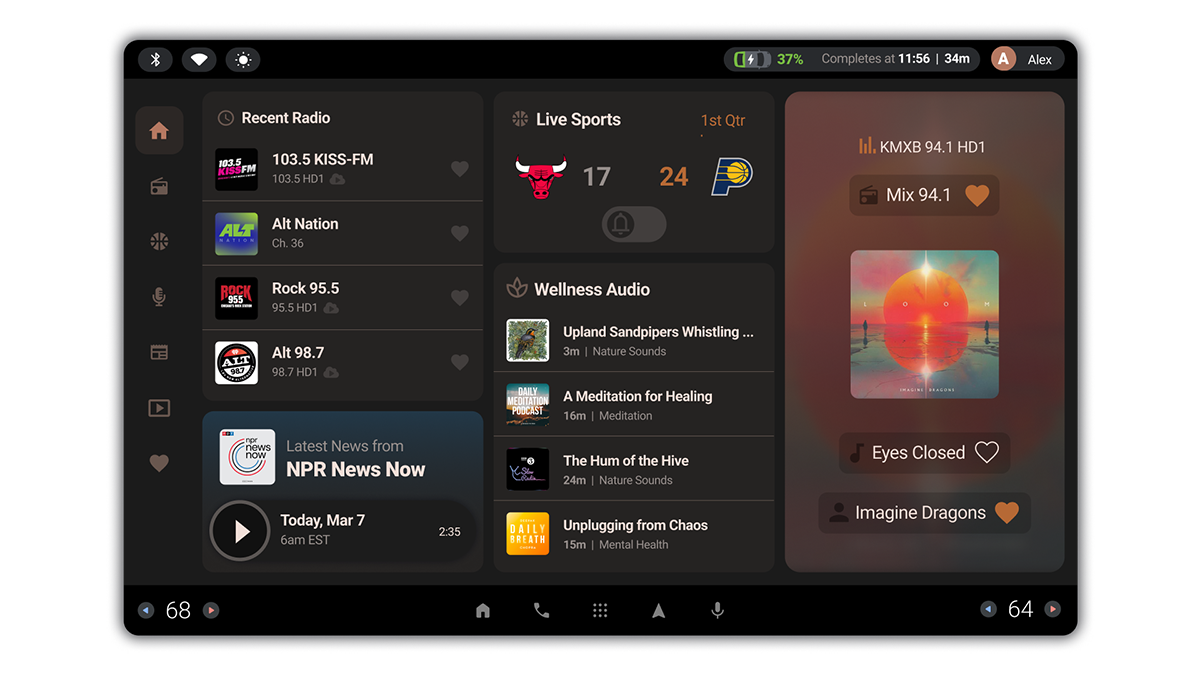Portable internet connectivity has become core to everyday life. In fact, our smartphones have become so ubiquitous that data from Parks Associates says they’re now more commonly owned than TVs. And away from home, in-car integrations let us embed our media lives directly to in-dash infotainment screens. The downside, however, is that the fragmentation of media has become difficult to navigate—especially when driving.
For clear reasons, audio is the primary source of in-car entertainment. And when we’re away from home, the majority of our audio consumption happens in the car: 66% of out-of-home radio listening happens in the car1.

Today’s media landscape provides consumers with multiple audio options to complement radio, especially when drivers mirror their smartphones through the infotainment systems in their cars. Even with the wide range of choice that our smartphones offer, however, news and sports drive the most engagement. We see this trend even more pronounced among streaming radio listeners, who spend a combined 32.7% of their listening time with these two formats.
The heavy consumption of news and sports among drivers presents a unique opportunity for automakers looking to improve the in-car media experience. Not only do smartphone integrations limit which apps can be mirrored on in-dash media screens, content discovery can be challenging.

Given our dependence on the internet, in-car connectivity is already omnipresent. Approximately 90% of the cars being built today are connected to the internet2, giving automakers the ability to own the in-car media experience—and raise the bar in the process. Based on feedback from a recent Gracenote study to understand in-car listening, unified content experiences would allow drivers to focus on the road ahead instead of juggling multiple apps to access different content.
In addition to streamlining in-car media engagement, unified, in-dash experiences allow automakers to serve up more of what drivers are most interested in. This is particularly relevant for news and sports—the two genres that already drive the most tune-in. Delivering live, in-dash sports data, for example, would be a home run for sports fans.

Integrating sports into the native infotainment screen also alleviates two of the biggest pain points among sports fans: finding what they’re looking for and knowing if they have access to it. Powerful metadata, infused with real-time sports data, removes discovery challenges and delivers more of what drivers are interested in.

Personalization and recommendations are also powerful engagement tools. Rich entertainment data give automakers the ability to recommend similar stations, offer team-related podcasts, aggregate audio content by topic (e.g., news, music, sports), generate snackable audio snippets and recommend content based on contextual signals, such as day of the week, destination and who’s in the car.

There’s no denying the importance of media in consumers’ daily lives. On average, U.S. adults spend three minutes shy of 10 hours each day3 with media across devices and channels. To capitalize on all of the media we now have at our fingertips, we’re continually adding new devices and ways to connect: The average U.S. household now has 17 connected devices4. With such immense fragmentation across consumers’ media lives, automakers have an opportunity to unify what matters to drivers and present it in a free-from-fragmentation experience.
Notes
- Nielsen audio measurement
- smartcar.com
- Nielsen National TV Panel; Q4 2024
- Parks Associates
To learn about Gracenote Nexus Auto, click here.
The streaming paradox: More content has led to less satisfaction
Viewer frustrations are on the rise as streaming service congestion increases, highlighting opportunities for improved UX and content discovery.
Streaming service congestion is fueling an uptick in FAST channel engagement
As streaming options proliferate, engagement with FAST channels is on the rise, with news and sports becoming top genres.
Why live sports are so hard to find on TV, and how publishers can help
Solving the sports discovery problem doesn’t mean owning more content. It means providing better access to it.
